 Below is a pictorial review of our kitten’s first 10 to 12 weeks here at RegencyRags including the finer points of our commitment to the health, temperment and beauty of our Ragdoll kittens.
Below is a pictorial review of our kitten’s first 10 to 12 weeks here at RegencyRags including the finer points of our commitment to the health, temperment and beauty of our Ragdoll kittens.
The socialization of RegencyRags kittens begins at birth. Each litter is awaited with much anticipation and advanced 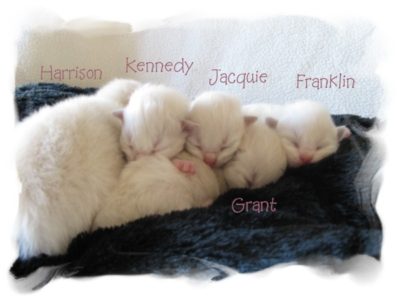
planning. I have a section of my home devoted to the kittening process that is warm, clean and quite. The mothers appreciate a peaceful place where they can birth their kittens. I am right there helping the mother deliver her babies. Together, the mothers and I clean the kittens, then I tuck them away in warm blankets until all the kittens are born and they are reunited. In this way the baby kittens feel the trust their mothers have in me and that trust/bond is transferred immediately. The kittens look to me for love and warmth just as their mother. There’s been time when I haven’t been able to be a the house when the kittens were due. At those times my darling husband has stepped in and played the role of mid-wife for me. (To the left is a one week old litter of blue bicolor kittens out of Daphne x Aristede from 02/08. Franklin became QGC RegencyRags Adonis of Burst and currently lives in Japan where he produces beautiful kittens just like himself.)
I stay with the mother and babies until the last one is delivered. This can sometimes take over six hours and it exhausts me as well as the mother. Only one time I’ve needed an emergency C-section when it turned out Daphne had a tubal pregnancy. Luckily most births are uneventful and the kittens are born without complications.
Once the babies are born and snuggling with their mother I can breathe a sigh of relief. Another successful litter 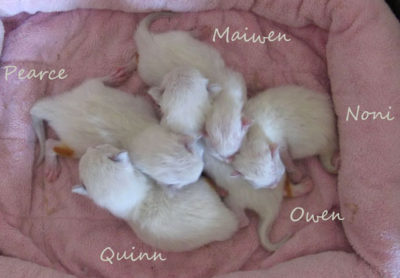 born to RegencyRags! From then on I’m with the babies every day holding them and giving them kisses. They are weighed daily at this point to make sure everyone is getting enough milk and are gaining an appropriate amount of weight. I give the kittens “birth names” from an alphabet lettering system I keep for each individual Queen. I’ve been asked many times how I can tell the kittens apart when I take their weights and keep records on the little itty ones. It’s simple. Shortly after birth I check the sex of the kittens then in a column I write the letters down with an appropriate name next to each letter. Like my first kitten was named Ashling. She was Josette’s A kitten. Then I take a drop of Iodine and mark each kitten — say on the right shoulder, then make a notation of that mark next to the kitten’s name. This way I can monitor weight and development until they’re old enough for me to tell them apart by color and pattern. Sometimes when I have an entire litter of blue bicolors, for instance, I continue using the iodine marks for identification for some time. (To the right is a litter of blue bicolor kittens at 4 days old. The orange spots are the iodine markers.)
born to RegencyRags! From then on I’m with the babies every day holding them and giving them kisses. They are weighed daily at this point to make sure everyone is getting enough milk and are gaining an appropriate amount of weight. I give the kittens “birth names” from an alphabet lettering system I keep for each individual Queen. I’ve been asked many times how I can tell the kittens apart when I take their weights and keep records on the little itty ones. It’s simple. Shortly after birth I check the sex of the kittens then in a column I write the letters down with an appropriate name next to each letter. Like my first kitten was named Ashling. She was Josette’s A kitten. Then I take a drop of Iodine and mark each kitten — say on the right shoulder, then make a notation of that mark next to the kitten’s name. This way I can monitor weight and development until they’re old enough for me to tell them apart by color and pattern. Sometimes when I have an entire litter of blue bicolors, for instance, I continue using the iodine marks for identification for some time. (To the right is a litter of blue bicolor kittens at 4 days old. The orange spots are the iodine markers.)
Normally I send around a picture of the newborns to those on the waiting list within the first week of the kittens 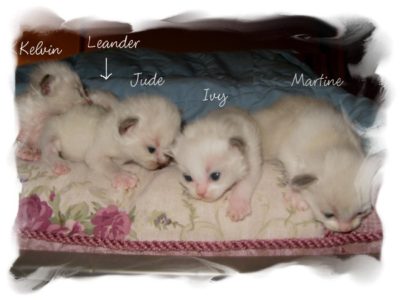 birth. Then I typically start sending out pictures once a week when the kittens reach 3 weeks old and it’s easier for me to take pictures of them. To take pictures of very young kittens means I have to disturb them, and I try to leave them cuddled with their mother as much as possible. Also, at 3 weeks old the kittens start to actually look like baby kittens — up until then I think they more resemble baby mice or hamsters! Plus until they turn 3 weeks old they wiggle around so much it’s hard to take a picture without flash that’s not fuzzy. So, I’ve inserted to the left a picture of a litter of blue bicolor kittens — and one blue mitted! — at 2 1/2 weeks old. I remember I took something like twenty pictures to get this one and still they weren’t looking in my direction. By 2 1/2 weeks old the kittens have had their eyes open about a week. I love looking through all my previous kitten photos. Each kitten is so precious to me. And if pressed I can actually name every single kitten ever born to RegencyRags. It may take me a few minutes and I have to write out the alphabet to do so, but I can do it!
birth. Then I typically start sending out pictures once a week when the kittens reach 3 weeks old and it’s easier for me to take pictures of them. To take pictures of very young kittens means I have to disturb them, and I try to leave them cuddled with their mother as much as possible. Also, at 3 weeks old the kittens start to actually look like baby kittens — up until then I think they more resemble baby mice or hamsters! Plus until they turn 3 weeks old they wiggle around so much it’s hard to take a picture without flash that’s not fuzzy. So, I’ve inserted to the left a picture of a litter of blue bicolor kittens — and one blue mitted! — at 2 1/2 weeks old. I remember I took something like twenty pictures to get this one and still they weren’t looking in my direction. By 2 1/2 weeks old the kittens have had their eyes open about a week. I love looking through all my previous kitten photos. Each kitten is so precious to me. And if pressed I can actually name every single kitten ever born to RegencyRags. It may take me a few minutes and I have to write out the alphabet to do so, but I can do it!
By three weeks old the kittens begin to venture out of the nest. This is a birthing box that keep the mother and 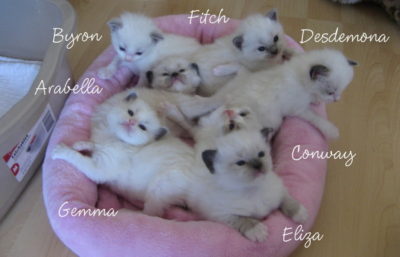 babies warm and secure. It’s fun to see them tumbling out of the box to follow mother to her water or food dish. But in the beginning the little kitten is confused once she makes that great step out of the box and cries for her mother to save her. So cute! Mother cats are known for their devotion to their kittens, and Ragdoll mothers are no different. So mother comes to the rescue and plops baby kitten back in the box. Eventually the kittens learn enough self-confidence that they actually take a few steps away from the nest. And then a few more. Kittens are naturally curious by nature, and even more so the Ragdoll kitten who by 3 weeks old recognizes my voice along with her mother’s. She wants to know what we’re doing because as every baby Ragdoll kitten knows, much more exciting things are always happening without her. (Pictured to the right is a litter of seven kittens at 3 wks old out of Sukie x Aristede.)
babies warm and secure. It’s fun to see them tumbling out of the box to follow mother to her water or food dish. But in the beginning the little kitten is confused once she makes that great step out of the box and cries for her mother to save her. So cute! Mother cats are known for their devotion to their kittens, and Ragdoll mothers are no different. So mother comes to the rescue and plops baby kitten back in the box. Eventually the kittens learn enough self-confidence that they actually take a few steps away from the nest. And then a few more. Kittens are naturally curious by nature, and even more so the Ragdoll kitten who by 3 weeks old recognizes my voice along with her mother’s. She wants to know what we’re doing because as every baby Ragdoll kitten knows, much more exciting things are always happening without her. (Pictured to the right is a litter of seven kittens at 3 wks old out of Sukie x Aristede.)
By week four, the kittens are scooting all over the place on their baby legs — no running or jumping yet, but that 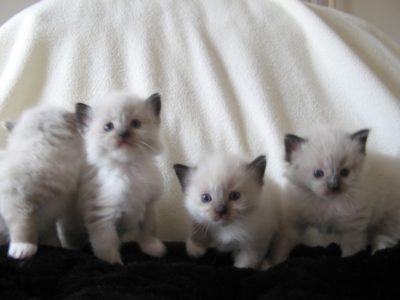 doesn’t mean they can’t get around on their own. It’s great fun to walk in the room and watch them toddle towards me. I pick them all up and give them lots of kisses. Each Ragdoll kittens receives plenty of love, that’s for sure. At 4 weeks old it’s a time for lots of love and coddling from both me and their mother. A typical day is milk from mother, sleep, a peek out of the nursing box to see what I’m doing, the tip of the tongue into the water bowl to see what mother’s been doing over there, and towards the end of the fourth week it’s time for the babies to sample a bit of canned food. I start the kittens off Nature’s Variety Instinct frozen raw in chicken. The kittens are naturally drawn to the raw meat. At this age they mostly walk around in it, then mother happily licks the kittens clean. Yet, some of the food does make it in their mouths. That first look of distaste is too funny. But eventually the kittens discover they like the solid food! It’s so sweet watching them nibble at the frozen raw patties. Yes, when they are really hungry they will eat the food even when it’s still frozen! (Pictured to the left is a litter of Seal Mitteds out of Josette x Aristede at 4 wks old: Zeus [looking away], Athena, Cupid and Bia.)
doesn’t mean they can’t get around on their own. It’s great fun to walk in the room and watch them toddle towards me. I pick them all up and give them lots of kisses. Each Ragdoll kittens receives plenty of love, that’s for sure. At 4 weeks old it’s a time for lots of love and coddling from both me and their mother. A typical day is milk from mother, sleep, a peek out of the nursing box to see what I’m doing, the tip of the tongue into the water bowl to see what mother’s been doing over there, and towards the end of the fourth week it’s time for the babies to sample a bit of canned food. I start the kittens off Nature’s Variety Instinct frozen raw in chicken. The kittens are naturally drawn to the raw meat. At this age they mostly walk around in it, then mother happily licks the kittens clean. Yet, some of the food does make it in their mouths. That first look of distaste is too funny. But eventually the kittens discover they like the solid food! It’s so sweet watching them nibble at the frozen raw patties. Yes, when they are really hungry they will eat the food even when it’s still frozen! (Pictured to the left is a litter of Seal Mitteds out of Josette x Aristede at 4 wks old: Zeus [looking away], Athena, Cupid and Bia.)
Then comes the start of litterbox training at 5 weeks old. That’s always a joy. The kittens are starting to be sure on 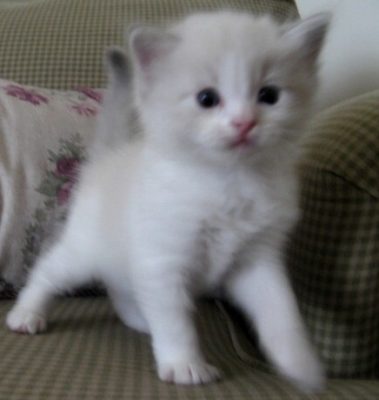 their feet, but they’re still babies and toddling around is really all they can do at this point. Yet, they’ve now decided the meat isn’t really all that bad, so it’s time to learn how to potty in the litterbox. This can be a challenge for some kittens. Others take to it right off. I start them with pine pellets (i.e. Feline Pine) and a low profile litterbox. My favorites for tiny kittens are long and wide because when one kitten pops in the box to potty the rest follow. It’s a mass potty experience. Some of the kittens just join in for the fun and start tossing litter around with their paws. I’d say at 5 weeks old the kittens are making it to the litterbox almost 50% of the time. At first they like to find their own spot. Sometimes I move the litterbox to where the group has decided to potty and this makes it easier on me. Suffice it to say that a lot of clean up is involved at this point. In going back through pictures to put on this page I find it interesting that if I skip a week taking pictures it’s normally Week 5. I know it’s because I spend most my time cleaning up after the babies. At this point the kittens start inspecting their mother’s Royal Canin Persian dry food and begin nibbling on that as well as the raw meat. It’s fine for the mother and kittens to supplement with the Royal Canin Persian dry food as long as they are also eating the raw meat because the Nature’s Variety Instinct frozen raw meat is best for the digestive tract of the Ragdoll. At 5 weeks old I start introducing different flavors of the Nature’s Variety. The top favorites of the adults and kittens alike are Duck and Rabbit — the most costly of the choices, of course. (Pictured to the right is Oz at 5 wks old, a gorgeous blue lynx bicolor male out of Daphne x Aristede).
their feet, but they’re still babies and toddling around is really all they can do at this point. Yet, they’ve now decided the meat isn’t really all that bad, so it’s time to learn how to potty in the litterbox. This can be a challenge for some kittens. Others take to it right off. I start them with pine pellets (i.e. Feline Pine) and a low profile litterbox. My favorites for tiny kittens are long and wide because when one kitten pops in the box to potty the rest follow. It’s a mass potty experience. Some of the kittens just join in for the fun and start tossing litter around with their paws. I’d say at 5 weeks old the kittens are making it to the litterbox almost 50% of the time. At first they like to find their own spot. Sometimes I move the litterbox to where the group has decided to potty and this makes it easier on me. Suffice it to say that a lot of clean up is involved at this point. In going back through pictures to put on this page I find it interesting that if I skip a week taking pictures it’s normally Week 5. I know it’s because I spend most my time cleaning up after the babies. At this point the kittens start inspecting their mother’s Royal Canin Persian dry food and begin nibbling on that as well as the raw meat. It’s fine for the mother and kittens to supplement with the Royal Canin Persian dry food as long as they are also eating the raw meat because the Nature’s Variety Instinct frozen raw meat is best for the digestive tract of the Ragdoll. At 5 weeks old I start introducing different flavors of the Nature’s Variety. The top favorites of the adults and kittens alike are Duck and Rabbit — the most costly of the choices, of course. (Pictured to the right is Oz at 5 wks old, a gorgeous blue lynx bicolor male out of Daphne x Aristede).
By weeks six and seven they’ve mastered the litterbox — almost! Okay, they still have a few accidents, but for the 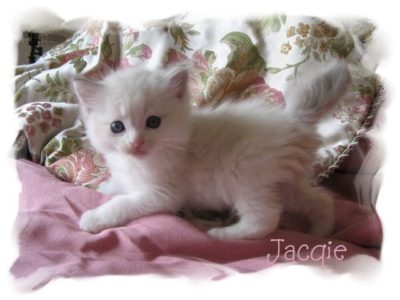 most part they use the box just like Mommy does. I reinforce their good potty habits by giving amble praise. Now the kittens can jump and run and play with toys. They’re exactly little miniature cats. I sit back and can’t believe how quickly they grow from week to week. The kittens stampede at me when I come to visit them. They love getting scratched behind the ears and being told how beautiful they are. Ragdoll kittens love to be told they’re beautiful and wonderful. At this age they really are quite entertaining to watch as they wrestle with their littermates. Sometimes they try to wrestle with Mother, but she teaches them quick she needs to be respected. It’s also my job to teach the babies I need to be respected, too, and that I’m not a littermate kitten they can bite and scratch. Depending on the size of the litter, it’s usually when the kittens turn 6 wks old that I start sending around individual pictures for everyone. Until then I normally send around a group shot. Also, it’s around 7 wks old that I can determine whether a kitten is pet or show quality. (Pictured to the left is Jacqie at 6 wks old, a blue lynx pt. bicolor female out of Daphne x Aristede who’s also pictured at the top of this page as a 1 wk old baby.)
most part they use the box just like Mommy does. I reinforce their good potty habits by giving amble praise. Now the kittens can jump and run and play with toys. They’re exactly little miniature cats. I sit back and can’t believe how quickly they grow from week to week. The kittens stampede at me when I come to visit them. They love getting scratched behind the ears and being told how beautiful they are. Ragdoll kittens love to be told they’re beautiful and wonderful. At this age they really are quite entertaining to watch as they wrestle with their littermates. Sometimes they try to wrestle with Mother, but she teaches them quick she needs to be respected. It’s also my job to teach the babies I need to be respected, too, and that I’m not a littermate kitten they can bite and scratch. Depending on the size of the litter, it’s usually when the kittens turn 6 wks old that I start sending around individual pictures for everyone. Until then I normally send around a group shot. Also, it’s around 7 wks old that I can determine whether a kitten is pet or show quality. (Pictured to the left is Jacqie at 6 wks old, a blue lynx pt. bicolor female out of Daphne x Aristede who’s also pictured at the top of this page as a 1 wk old baby.)
 The health and subsequent well-being of our Ragdoll cats and kittens is of the utmost importance to us, equal to temperament and beauty. As a hobby breeder, I am able to keep the number of cats I keep in my cattery small. This in turn decreases the risk of disease — most importantly the dreaded FIP virus. Unlike dogs that live in packs, cats are typically solitary creatures who live alone or in small groups of two or three. They are companionable and in the wild (as feral cats) they do form small colonies, but never in large numbers seen in dog packs. Because of this cats do not have a naturally strong immune system. Their immune systems are easily stressed when kept around a large number of other cats. This stress leads to a higher susceptibility to disease.
The health and subsequent well-being of our Ragdoll cats and kittens is of the utmost importance to us, equal to temperament and beauty. As a hobby breeder, I am able to keep the number of cats I keep in my cattery small. This in turn decreases the risk of disease — most importantly the dreaded FIP virus. Unlike dogs that live in packs, cats are typically solitary creatures who live alone or in small groups of two or three. They are companionable and in the wild (as feral cats) they do form small colonies, but never in large numbers seen in dog packs. Because of this cats do not have a naturally strong immune system. Their immune systems are easily stressed when kept around a large number of other cats. This stress leads to a higher susceptibility to disease.
Most cats come in contact with what’s known as the Corona Virus. It’s like the cold virus in humans — we all come in contact with it at some point. And like the human cold virus, the corona virus is typically harmless in a healthy cat of kitten with a well-developed immune system. However, in some cats — and we don’t know the exact causes, although it’s hypothosized that stress is the leading factor — that corona virus mutates into FIP. Catteries with a higher cat count are naturally more prone to FIP due to the stress cats endure by being kept with a high number of other cats. (For more information on FIP and its causes, please visit http://www.sockfip.org/).
Some reports indicate that households with more than four cats begin to become more suseptible to the corona virus mutation. The higher that number increases the higher the stresses. This means that most catteries having more than four cats are at risk for FIP. That puts a big responsibility on breeders to keep their cats as healthy as possible. One of those ways is to keep the litter boxes scooped twice a day and the boxes sterilized with a bleach solution once a week to kill the corona virus. The second step is to keep the cats in smaller “colonies” in the house — in groups of no more than four cats. Here are RegencyRags I have my nine cats separated into three groups that each have their own litterboxes, sleeping quarters, water and food dishes. Everyday these groups get to spend time with the family. They are never cooped up and kept from the love and attention all Ragdoll cats need. Yet, keeping them in distinct living quarters ensures that diseases are kept to a minimum. Likewise, when I’m showing a cat — like I did with Bruno during the show season 2010-2011 — I kept him with one other female in my own bathroom so that when he came home from shows he wasn’t spreading anything he might have picked up in the hotel room or showhall to the rest of the cats — most importantly away from the baby kittens that have little to no immunity during the first 8 weeks of their lives. Your RegencyRags kitten receives his first vaccine at 8 weeks old and at this time he’s allowed to receive his first visitors.
The health of the Ragdoll kittens produced by me depends heavily on the health of the parents. I take excellent care of my cats. They want for nothing. I primarily feed Royal Canin dry and various grain-free canned food along with Nature’s Variety Instinct Raw food. For a long time I thought breeders who fed frozen raw were over doing it a bit — until I tried it myself and saw the difference in the cats. Not only are they healthier and happier, they have better weight, silkier coats, and smaller, denser stools with less order. I love the side benefit of less odor the best!
Most of my breeding cats are retired before they reach 3 years old so that they can experience the best a family life as a spayed/neutered pet can offer. My outstanding producers are the exception, but even then the oldest breeding female I’ve ever had was 4 1/2 years at her retirement. At this point, Aristede is the longest I’ve ever kept a breeding cat. He’s been with me since his birth and will turn 5 years old on July 1, 2011. Aristede is spoiled rotten and leads a pampered exsistence so I’m not worried about keeping him breeding with the girls for another two or three years. Once he’s retired I’ve decided Aristede will definitely stay with me. I get to be his forever home! He’s the very last of my kittens that were born when the cattery was still in California and I just can’t give that up. Call me sentimental, it’s true, but I also know that once Aristede reaches 7 or 8 years old and his retirement I’m going to want to be the one who coddles him into his old age. (Update 11/2012 — I couldn’t wait any longer — Aristede is retired. It’s so much fun having him roam the house as a pet. He’s so much fun to have around the house. I’ve noticed that since he’s been neutered his fur is much longer, thicker and silkier than ever. He also weighs quite a bit more. I didn’t think it could happen, but he’s actually grown bigger since he’s been neutered. )
 The last but not least level of excellence I strive for in my Ragdoll cats and kittens is beauty. I actively show for confirmation in TICA. This is the same organization in which my kittens are registered. I aim for a sweet doll face, a medium length rabbit soft coat, sparkling blue eyes, long fluffy tails, medium long length to the body with good musculature and good size, along with the finer points of show conformation including but not limited to excellent modified wedge head type, pronounced change of direction from nose to forehead without creating a break, strong chins, correct eye shape and placement, medium size ears with proper placement, and a wide muzzle.
The last but not least level of excellence I strive for in my Ragdoll cats and kittens is beauty. I actively show for confirmation in TICA. This is the same organization in which my kittens are registered. I aim for a sweet doll face, a medium length rabbit soft coat, sparkling blue eyes, long fluffy tails, medium long length to the body with good musculature and good size, along with the finer points of show conformation including but not limited to excellent modified wedge head type, pronounced change of direction from nose to forehead without creating a break, strong chins, correct eye shape and placement, medium size ears with proper placement, and a wide muzzle.
Feel free to browse my galleries for many pictures of my Ragdoll cats and kittens I’ve taken over the years. Click the Galleries tab to the left. The pictures speak of the beauty I strive for in my cats. I also have many pictures posted on my Previous Kittens page that have been sent in by kitten buyers. I love to get pictures of my babies because it helps me to what the tiny kittens look like as they mature. Sometimes the pets don’t have the perfect markings of a show Ragdoll cat or kitten, but the beauty is still there.
I like to think that these three key elements of health, temperament, and beauty make a RegencyRags Ragdoll stand out from the rest. They shout out: Notice me! to even the casual passerby because they are all that.
